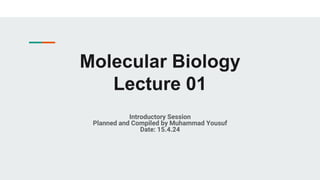
Introduction to molecular biology (basic terminologies)
- 1. Molecular Biology Lecture 01 Introductory Session Planned and Compiled by Muhammad Yousuf Date: 15.4.24
- 2. Objective: ● The present lecture has been designed to set the ground for our prospective lecture series. In this lecture you’ll be introduced to some of the preliminary concepts of genetics ● Once you develop a better understanding of the basics, we’ll proceed with bottom-up approach while absorbing each concept at a time ● Feel free to ask questions…
- 3. Molecular Genetics is a discipline which primarily deals with the inter-relationship between two nucleic acids, DNA and RNA, and how these are used to synthesize polypeptides, the basic component of all proteins Tidbit: It is essential to note that RNA may have been the hereditary material at a very early stage of evolution, but now, except in certain viruses, it no longer serves this role Gene: A gene is a part of a DNA molecule that serves as a template for making a functionally important RNA molecule. In eukaryotes, the small DNA molecules of the mitochondrion or chloroplast contain a few genes (tens up to hundreds) but the nucleus often contains thousands of genes, and complex eukaryotes typically have tens of thousands.
- 4. Coding RNA sequence: The coding RNA sequence encodes a corresponding polypeptide sequence. Since, this class of RNA carries genetic information from DNA to the protein synthesis machinery. It is often regarded as messenger RNA (mRNA) Note: Messenger RNA made in the nucleus needs to be exported to the cytoplasm to make proteins, but the messenger RNA synthesized in mitochondria and chloroplasts is used to make proteins within these organelles Non-coding RNA sequence: The other RNA class is noncoding RNA. Such molecules do not serve as templates for making polypeptides. Instead they are often involved in assisting the expression of other genes. Example includes ribozymes
- 5. Base Pairing among DNA and RNA The base composition of DNA is not random: the amount of A equals that of T, and the amount of G equals that of C. The base composition of DNA can therefore be specified by quoting the percentage of GC (= percentage of G + percentage of C) in its composition. For example, DNA with 42% GC has the following base composition: G, 21%; C, 21%; A, 29%; T, 29% Forms of DNA (A, B and Z) https://www.youtube.com/watch?v=bWaXJfyXfCQ https://www.youtube.com/watch?v=o_-6JXLYS-k
- 6. Most genes are expressed to make polypeptides Most eukaryotic genes are expressed to produce polypeptides using RNA polymerase II, one of three RNA polymerases. All three RNA polymerases cannot initiate transcription by themselves: they require regulatory factors. 1. Promoter: Promoter is a crucial regulatory element, a collection of closely spaced short DNA sequence elements in the immediate vicinity of a gene. Promoters are recognized and usually promotes the binding of transcription factors that then guide and activate the polymerase. Transcription factors are said to be trans-acting, because they are produced by remote genes and need to migrate to their sites of action. In contrast, promoter sequences are cis-acting because they are located on the same DNA molecule as the genes they regulate.
- 7. Promoters recognized by RNA polymerase II often include the following elements: The TATA box Often TATAAA, or a variant sequence, this element is usually found about 25 base pairs (bp) upstream from the transcriptional start site (designated by –25). It usually occurs in genes that are actively transcribed by RNA polymerase II only at a particular stage in the cell cycle (e.g. histone genes) or in specific cell types (e.g. the ß-globin gene) A mutation in the TATA box does not prevent the initiation of transcription but causes transcription to begin at an incorrect location
- 8. The GC box: Usually a variant of the sequence GGGCGG, the GC box occurs in a variety of genes, many of which lack a TATA box. This is the case for the ‘housekeeping’ genes that perform the same function in all cells (such as those encoding DNA and RNA polymerases, histones, or ribosomal proteins). Although the GC box sequence is sequentially asymmetrical, it seems to function in either orientation The CAAT box: Often located at position –80 it is usually the strongest determinant of promoter efficiency. Like the GC box, it functions in either orientation.
- 9. Promoters for two eukaryotic genes encoding polypeptides. Polypeptide-encoding genes are transcribed by RNA polymerase II. The promoters are defined by short sequence elements located in regions just upstream of the transcription start site (+1). (A) The b-globin gene promoter includes a TATA box (orange), a CAAT box (purple), and a GC box (blue). (B) The glucocorticoid receptor gene is unusual in possessing 13 upstream GC boxes: 10 in the normal orientation, and 3 in the reverse orientation (alternative orientations for GC box elements are indicated by chevron directions).
- 10. For a gene to be transcribed by RNA polymerase II the DNA must first be bound by general transcription factors, to form a preinitiation complex. General transcription factors required by RNA polymerase II include TFIIA, TFIIB, TFIID, TFIIE, TFIIF, and TFIIH. The complex that is required to initiate transcription by an RNA polymerase is known as the basal transcription apparatus Tutorials: https://www.youtube.com/watch?v=7oXpi4-B8Yg https://www.youtube.com/watch?v=vXw-QU7v4dw
- 11. Enhancer: An enhancer is a cluster of cis-acting short sequence elements that can enhance the transcriptional activity of a specific eukaryotic gene. Unlike a promoter, which has a relatively constant position with regard to the transcriptional initiation site, enhancers are located at variable (often considerable) distances from their transcriptional start sites. Furthermore, their function is independent of their orientation. Enhancers do, however, also bind gene regulatory proteins. The DNA between the promoter and enhancer sites loops out, which brings the two different DNA sequences together and allows the proteins bound to the enhancer to interact with the transcription factors bound to the promoter, or with the RNA polymerase